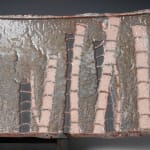Wakao Toshisada 若尾利貞 Japanese, b. 1933
H10.1 x W58.4 x D27.9 cm
Further images
-
(View a larger image of thumbnail 1
)

-
(View a larger image of thumbnail 2
)

-
(View a larger image of thumbnail 3
)

-
(View a larger image of thumbnail 4
)

-
(View a larger image of thumbnail 5
)

-
(View a larger image of thumbnail 6
)

-
(View a larger image of thumbnail 7
)

-
(View a larger image of thumbnail 8
)

-
(View a larger image of thumbnail 9
)

This plate invokes, "The Tale of the Bamboo Cutter," a classical Japanese monogatari from the 10th century Heian period. The tale recounts the discovery of a tiny princess inside a mysterious bamboo stalk by an old bamboo cutter:
The bamboo cutter and his wife raise her as their own daughter, naming her Nayotake-no-Kaguya-hime. With each bamboo stalk cut, they find gold nuggets inside, leading to their wealth. As Kaguya-hime grows rapidly into a woman of extraordinary beauty, she reveals her extraterrestrial origin and departure to the Moon.
This timeless tale has inspired various interpretations across mediums. Wakao Toshisada's depiction of a bamboo grove pays homage to the beginning of this tale, invoking its enduring legacy. The evocative style is in line with Wakao’s admiration for the Rinpa School of Painting, which often contained references to nature, the seasons, and motifs drawn from Japanese literature.








